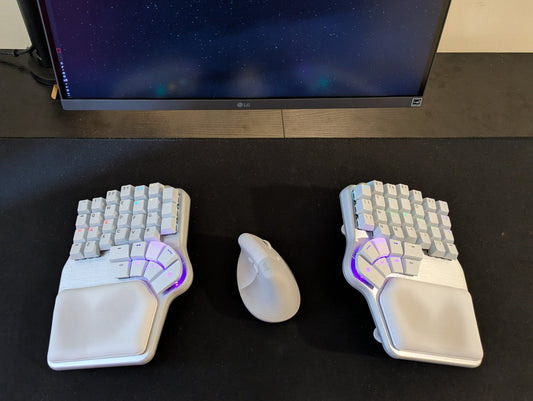Today, we will dive into what makes a keyboard ergonomic –specifically, busting certain myths surrounding ergonomic keyboards.
We're going to coin them as.....*drumroll*
Ergonomyths!
You heard it here first.
But before we get "a bustin'," let's first identify the true definition of ergonomics:
You'll find that across the majority of definitions for ergonomics, a pattern of the same concept continues to arise:
Working safely, with less discomfort, and optimized well-being.

That's our primary goal, right?
You might think your primary goal is to work faster or more efficiently, but how is that even possible if you spend half of your day in discomfort?
So, based on this concept, let's get a bustin'.
Having a negative tilt is an absolute must.
Most conventional keyboards have a positive tilt where the back is higher than the front, forcing you to extend your wrists, which creates pressure on the tissues and vessels.

A negative tilt, instead, allows the 'au naturel' neutral wrist position, which is generally advised when typing your cute little derrière off for hours on end.

But is the negative tilt ideal in all situations? The answer is no.
Despite being an excellent feature in certain environments, it can become a hindrance in others.
For example, if your keyboard sits above the level of your elbows, you'd find yourself in an almost funky 'T-rex '-like position, with flexed elbows forcing your hands to scale the negative slope to reach for those further keys.
Regardless of the model, it depends on the distance between your body and the desk. If you can sit so that your arms are parallel to the floor, you're good to go.
Something else you might want to consider is the size of your hands. A negative slope makes the keys a little harder to reach. Meaning it may not be the best choice for those with smaller hands.
However, a keyboard with reverse tilting really shines in a working environment that provides an adjustable desk and chair. Though, we'd always suggest a design with foldable legs, giving you a little more freedom with your wrist position and working environment.

So, Negative tilt is an absolute must - busted!
Flat keyboards are always better than those with a positive slope.
As mentioned, wrist extension is one of keyboard ergonomics' most notorious boogeymen.
It's pretty fair to say that any aggressive positive keyboard slope will only encourage some form of wrist extension, and nobody needs unnecessary wrist extension.

So, does this mean a keyboard with a neutral slope is always better?
I mean, does this make a laptop's keyboard more ergonomic than our Defy keyboard?
Thankfully, no. There are a couple of things to consider first... On a small side note, this brings us to an article written in April 2022 by a little-known publication called the New York Times.
Now, we were mentioned in this article, but not exactly how we would have wanted:
This statement, along with the idea that flat laptop keyboards are more ergonomic than the Dygma Raise, fails to take into account our wonderful palm pad additions.

These elevate the palms to counteract any problem that the slight slope may present.
It's also important to consider whether or not the user tends to float their hands above the keyboard or rest them on the desk.
If you rest your hands on the desk and your keyboard doesn't have palm rests, you'll get wrist extension despite using a flat keyboard.
Ultimately, it's the difference in height between where you rest your palms and the highest point of the keyboard that matters.
This means that the height of the keyboard can have a more significant effect on wrist extension than the slope itself.
In other words, a tall keyboard with a neutral slope can be even worse than a thin keyboard with a light positive tilt.

This has been busted.
Keyboard tenting rules- every other way sucks
Take a look at your hand and look at your hand position right now. Unless you're typing... or riding a mountain bike, your hands are probably at a more neutral 'handshake' angle, right?
When we turn our hands inwards to type –otherwise known as wrist pronation– tension is created in the forearm and wrist as the ulnar and radius bones create somewhat of a scissor effect.
As a result, more and more devices are being designed to relieve that unnatural wrist pronation, from vertical mice to road bike handlebars!
That said, just like with the negative tilt, it depends on your working environment. Naturally, any tented or vertical device would lead to an elevation in that said device.

So, if your desk and chair cannot adjust to suit this new slight change in height, you may find the discomfort leaves your wrist but ends up in your back, shoulders, or neck.
Another thing to consider is the vast amount of work on your fingers. Think about it; you're the average data-entry clerk typing 50 words per minute for 5 hours a day. That's almost 70,000 keystrokes a day!
Gravity is working with you on a non-tented keyboard, if even just a little. Which means there's far less strain on the fingers over time.

But with a tented keyboard, more effort is needed, which could increase the workload on your fingers.
Although there's currently no conclusive research to support this claim, it's something to consider.
Unless you're regularly performing the first dance motion of the Macarena, it's best to keep your hands in as neutral a position as possible. And tenting supports this, but it ultimately falls to you and your working environment.
So, what should we call this? - PLAUSIBLE
That key well keyboards are far more ergonomic.
Well, regular keyboards often leave us reaching for faraway keys like the number keys, F keys, and Backspace or Enter.
Here, we find our wrists deviating away from the center of the keyboard.
Increasing a nasty little thing called ulnar deviation...
Ulnar deviation, or ulnar drift, refers to the motion in which your hand bends at the wrist toward your pinkie finger. This can lead to wrist pain, joint problems, and swelling.

Keyboards with a key well bring the keys closer together to reduce the distance your fingers travel to reach them.
I mean, what in Skywalker's name is that? It looks like an inverted Death Star.
That being said, some negatives of the key well arise when discussing, again, the size of your hands.
With the keys being so close together, those with larger hands may find themselves compressing their fingers to reach the keys on the inner side of the well.
Whereas those with smaller hands may be forced to overstretch and reach the keys on the well's outer side.

Furthermore, creating a key well requires a taller keyboard, which demands a higher seated position, allowing you to place your hands accordingly.
If you like the idea of a key well, be sure to test it out first. Or get it from a company with a good return policy.
Keyboards are a bit like Cinderella's slipper; it'll either fit or not, it won't be somewhere in-between.
So this is - BUSTED!
Thumb keys will ALWAYS be ergonomic.
Back to our old foe, Mr. Ulnar Deviation. The primary goal of thumb keys is to reduce this movement as much as possible by bringing those previously mentioned outer ring keys to the center of the keyboard.

Better yet, we can place those keys to be used by the true powerhouse of the hand.... the thumb!
Unfortunately, we've found that it's not as simple as that. There are three things to consider: the shape of the keycaps, how they are grouped... and the pinkie's position.
Yes, where you place your pinkie affects the thumb.
Let's start with how the keycaps are grouped. There are two schools of thought regarding thumb clusters: the thumb block and the thumb curve.

The first allows for more keys to be close together, and the second follows the natural arc of your thumb.
While designing the thumb cluster for the Dygma Defy, we opted for a thumb curve but engineered a way to add more keys with a second row of low-profile keys.
If you want to learn about the Defy thumb cluster, check out this other video Another thing you'll notice in our thumb clusters is that the keys are not concave (like most) but convex. That's because the shape of the key also matters when using a thumb cluster.
In early versions of the Dygma Raise and Dygma Defy keyboards, we tried to create a thumb cluster of standard OEM keycaps. This would allow more customization options for our awesome users.
But it was a disaster.
No matter where we placed the keys or how we spaced them, it didn't feel right.
The shape of the keys interrupted finger movement, which resulted in discomfort over time.
Not good!
Finally, during our testing phases, we discovered that the thumb and pinkie had an intimate relationship.

When one goes up, the other goes down, and vice versa. This is why we moved the outmost columns down –the pinkie stagger– to help the thumb rest in the correct position.
So, are thumb keys ALWAYS ergonomic? - PLAUSIBLE!
Like most, if not all, ergonomyths mentioned today, it simply falls down to the users' preference. You might prefer having more keys even though you need to stretch your thumb to reach them, or you want fewer keys within natural reach.
Of course, no keyboard is ergonomic if you're using the wrong setup or not practicing proper posture.
Even keyboards that identify as having the most ergonomic features may still have their faults.
It's ultimately about you, the user.
Your hand size, working setup, typing style, wants, and needs all play a role in choosing the perfect ergonomic keyboard for you.
Today, we only scratched the surface of ergonomyths; we're planning to cover the productivity aspect of ergonomics too.
Ciao for now!









